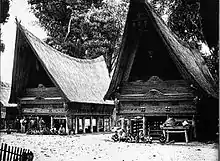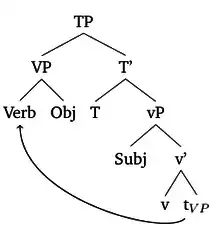Toba Batak language
Toba Batak (/ˈtoʊbə ˈbætək/[2]) is an Austronesian language spoken in North Sumatra province in Indonesia. It is part of a group of languages called Batak.
| Toba Batak | |
|---|---|
| Hata Batak Toba ᯂᯖ ᯅᯖᯂ᯲ ᯖᯬᯅ | |
 Batak written in Surat Batak (Batak script) | |
| Native to | Indonesia |
| Region | Samosir Island (2° 30′ N, 99°), and to the east, south, and west of Toba Lake in north Sumatra. |
| Ethnicity | |
Native speakers | 1,610,000 (2010 census)[1] |
Austronesian
| |
| Latin, Batak alphabet | |
| Language codes | |
| ISO 639-3 | bbc |
| Glottolog | bata1289 |

There are approximately 1,610,000 Toba Batak speakers, living to the east, west and south of Lake Toba. Historically it was written using Batak script, but the Latin script is now used for most writing.
Nomenclature

The name of this language arises from a rich and complex history of ethnic identity in colonial and post-colonial Indonesia. It is a generic name for the common language used by the people of the districts of Toba, Uluan, Humbang, Habinsaran, Samosir, and Silindung, centered upon the Island of Sumatra; more particularly, at Lake Toba. Linguistically and culturally these tribes of people are closely related. Other nearby communities such as Silalahi and Tongging may also be classified as speakers of Toba Batak.
The term Toba Batak is, itself, a derivation of the Toba Batak language. As such, it is used both as a noun and an adjective, both to describe a language, and also to describe the people who speak the language.
Among the aforementioned districts, Toba is the most densely populated and politically the most prominent district so that Toba Batak became a label for all communities speaking a dialect closely akin to the dialect spoken in Toba. In contemporary Indonesia the language is seldom referred to as Toba Batak (bahasa Batak Toba), but more commonly and simply as Batak (bahasa Batak). The (Toba)-Batak refer to it in their own language as Hata Batak. This "Batak" language is different from the languages of other Batak people that can be divided into speaking a northern Batak dialect (Karo Batak, and Pakpak-Dairi Batak – linguistically this dialect group also includes the culturally very different Alas people), a central Batak dialect (Simalungun) and closely related other southern Batak dialects such as Angkola and Mandailing.
Background

There are several dictionaries and grammars for each of the five major dialects of Batak (Angkola-Mandailing, Toba, Simalungun, Pakpak-Dairi, and Karo). Specifically for Toba Batak the most important dictionaries are that of Johannes Warneck (Toba-German) and Herman Neubronner van der Tuuk (Toba-Dutch). The latter was also involved in translating the Christian Bible into Toba Batak.
Phonology
This description follows Nababan (1981).[3]
Consonants
| Labial | Dental/ Alveolar |
(Alveolo-) palatal |
Velar | Glottal | ||
|---|---|---|---|---|---|---|
| Nasal | m | n | ŋ | |||
| Plosive/ Affricate |
voiceless | p | t | t͡ɕ | k | |
| voiced | b | d | d͡ʑ | ɡ | ||
| Fricative | s | h | ||||
| Trill | r | |||||
| Approximant | w | l | j | |||
Vowels
| Front | Central | Back | |
|---|---|---|---|
| Close | i | u | |
| Close-mid | e | (ə) | o |
| Open-mid | ɛ | ɔ | |
| Open | a |
Note:
- /ə/ only occurs in loanwords from Indonesian.
Stress
Stress is phonemic, e.g. /'tibbo/ 'height' vs. /tib'bo/ 'high'; /'itɔm/ 'black dye' vs. /i'tɔm/ 'your sibling'.
Syntax
Toba Batak has verb-initial, VOS word order, as with many Austronesian languages. In (1), the verb mangallang 'eat' precedes the object kue 'cake', and the verb phrase precedes dakdanak i 'the child'.
Mangallang
AT-eat
kue
cake
dakdanak
child
i.
the
'The child is eating a cake.' (Silitonga 1973:3)
SVO word order (as in English), however, is also very common (Cole & Hermon 2008). In (2), the subject dakdanakon 'this child' precedes the verb phrase mangatuk biangi 'hit the dog'.
Dakdanak-on
child-this
mang-atuk
ACT-hit
biang-i.
dog-DEF
'This child hit the dog.' (Cole & Hermon 2008)

Cole and Hermon (2008) claim that VOS order is the result of VP-raising (specifically, of VoiceP) (Figure 1). Then, the subject may optionally raise over the verb phrase because of information structure. This analysis provides a basis for understanding Austronesian languages that have more fully become SVO (e.g. Indonesian: Chung 2008;[4] Jarai: Jensen 2014[5]).
Like many Austronesian languages (e.g. Tagalog), DP wh-movement is subject to an extraction restriction (e.g. Rackowski & Richards 2005). The verb in (3a) must agree with aha 'what' (in (3a): TT or "theme-topic") for it to be extracted in front of the verb. If the verb agrees with the subject, si John 'John' (in (3b): AT or "actor-topic"), aha 'what' may not extract.
Aha
what
diida
TT.see
si
PM
John?
John
'What did John see?' (Cole & Hermon 2008) Unknown glossing abbreviation(s) (help);
*Aha
what
mangida
AT.see
si
PM
John?
John
Intended: 'What did John see?' (Schachter 1984:126) Unknown glossing abbreviation(s) (help);
Notes
- Toba Batak at Ethnologue (25th ed., 2022)

- Bauer, Laurie (2007). The Linguistics Student's Handbook. Edinburgh: Edinburgh University Press.
- Nababan (1981), p. 1–41
- Chung, Sandra (2008). "Indonesian clause structure from an Austronesian perspective". Lingua. 118 (10): 1554–1582. doi:10.1016/j.lingua.2007.08.002.
- Jensen, Joshua (2014). Jarai Clauses and Noun Phrases. Pacific Linguistics. Mouton de Gruyter.
References
- Musgrave, Simon (2001). Non-subject Arguments in Indonesian. Ph.D. Thesis. See page 101 and reference to Cole, Peter & Gabriella Hermon (2000) Word order and binding in Toba Batak. Paper presented at AFLA 7, Amsterdam
- Nababan, P. W. J. (1981). A Grammar of Toba-Batak. Pacific Linguistics Series D – No. 37. Canberra: Dept. of Linguistics, Research School of Pacific Studies, The Australian National University. doi:10.15144/pl-d37. hdl:1885/145092.
- Tuuk, Hermanus Neubronner van der (1971) [first published in Dutch 1864–1867]. Teeuw, A.; Roolvink, R. (eds.). A Grammar of Toba-Batak. Translated by Scott-Kemball, J. The Hague: M. Nijhoff.
- Percival, W.K. (1981). A Grammar of the Urbanised Toba-Batak of Medan. Pacific Linguistics Series B - No. 76. Canberra: Dept. of Linguistics, Research School of Pacific Studies, The Australian National University. doi:10.15144/pl-b76. hdl:1885/144535. ISBN 0-85883-237-2.
- Rackowski, Andrea; Richards, Norvin (2005). "Phase Edge and Extraction: A Tagalog Case Study". Linguistic Inquiry. 36 (4): 565–599. doi:10.1162/002438905774464368. S2CID 57570090.
- Cole, Peter; Hermon, Gabriella (2008). "VP Raising in a VOS Language". Syntax. 11 (2): 144–197. doi:10.1111/j.1467-9612.2008.00106.x.
- Schachter, Paul (1984), "Semantic-Role-Based Syntax in Toba Batak", UCLA Occasional Papers in Linguistics, 5: 122–149
- Silitonga, Mangasa (1973). Some Rules Reordering Constituents and their Constraints in Batak (Ph.D thesis). University of Illinois.
External links
- OLAC resources in and about the Batak Toba language
- Reference to contemporary Batak Bible
- Example translation of Biblical Scripture (published by the Language Museum, a site published by Zhang Hong, an internet consultant and amateur linguist in Beijing China)
- Sejara Indonesia An Online Outline of Indonesia History.